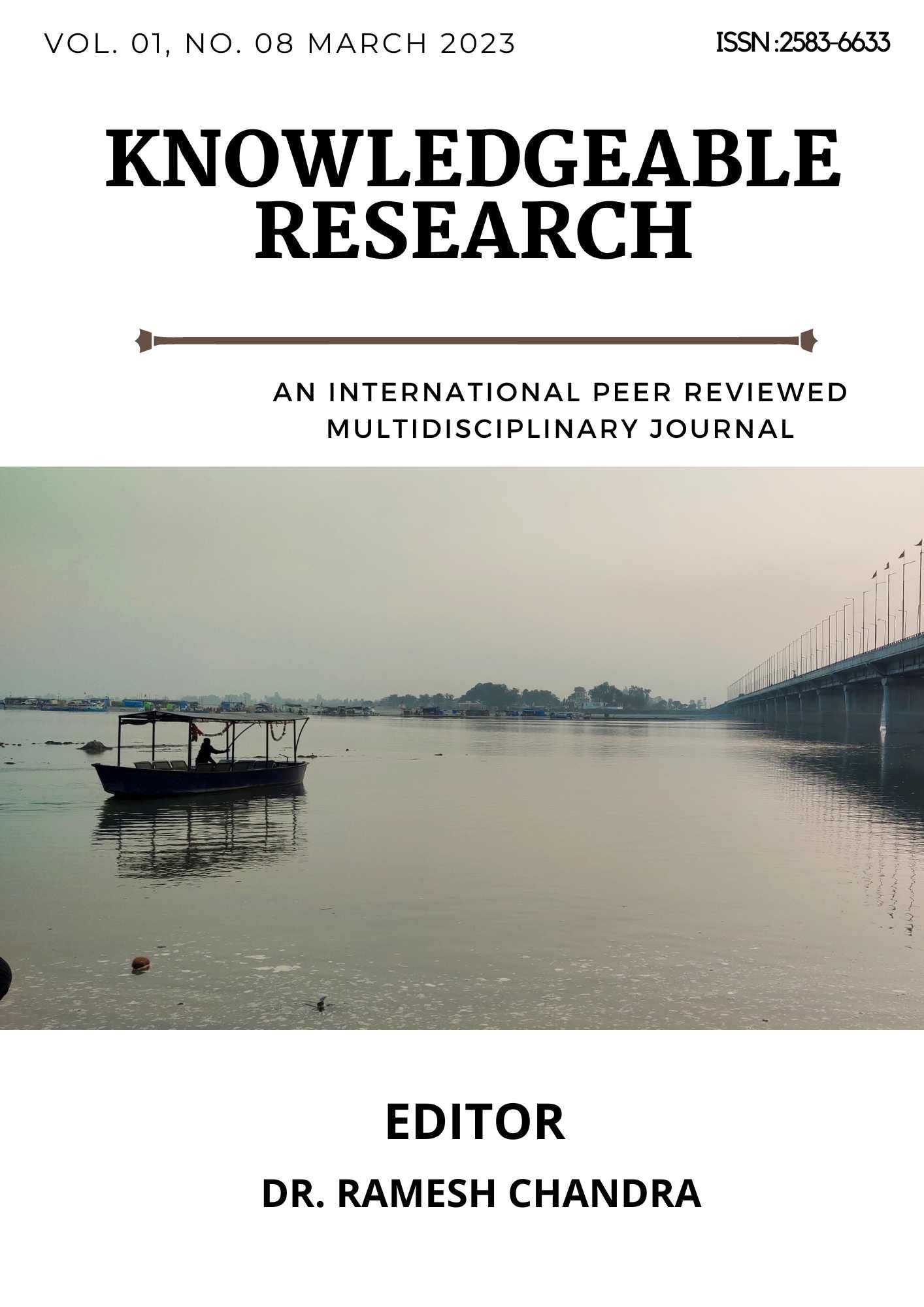Determinants of Cryptocurrency: An Analysis of Volatility and Risk-Return Trade-Off
Main Article Content
Abstract
As an investor, volatility plays an important role in decision making. It is defined as the rate at which a security’s price increases or decreases, i.e., shows pricing behavior during a definite span of time. A high volatility will lead to high risk. Thus, it becomes critical to determine the volatility and the risk-return trade-off among investments. This paper tries to document the volatility and risk-return trade-off of four prominent crypto-currencies (Bitcoin, Ethereum, Binance and Ripple), based on market-capitalization. For analysis, closing prices of cryptocurrencies has been accumulated through secondary method for 365 days, starting from 1st March 2022 and ending on 28th February 2023. Standard Deviation and Kurtosis, used together for volatility and risk assessment, documented that Bitcoin has the highest volatility and risk associated with expected returns. Regression, for assessing the impact of volatility in BTC price on others, derived that ETH has a strong, but not very strong, bivariate relationship with BTC, among all the pairs. Durbin Watson (DW) test concluded that there was no auto-correlation in the prices of crypto-currencies, i.e., previous day’s price does not play significant role in today’s price. For risk-return trade-off, Coefficient of Variation (CoV) has been applied. It determined that Ethereum has the highest ratio indicating its non-suitability to a conservative investor because of having the lowest returns as compared to risks involved; while Binance has the lowest Coefficient of Variation (CoV) depicting lower risk and maximum return among all.
Article Details

This work is licensed under a Creative Commons Attribution-NonCommercial-NoDerivatives 4.0 International License.
References
Amsyar, I., Christopher, E., Dithi, A., Khan, A. N., & Maulana, S. (2020). The Challenge of Cryptocurrency in the Era of the Digital Revolution: A Review of Systematic Literature. Aptisi Transactions on Technopreneurship (ATT), 2(2), 153–159. https://doi.org/10.34306/att.v2i2.96
Hong Hin, L. (2020). Critical Review: Current Research Issues on Crypto-currency and its Application in Financial Sectors. International Journal of Business and Management, 15(3), 145. https://doi.org/10.5539/ijbm.v15n3p145
Ichsani, S., & Mahendra, N. S. (2022). Return and Risk Analysis on Cryptocurrency Assets. Kontigensi: Scientific Journal of Management, 10(1), 149–160. www.coingecko.com
Dasman, S. (2021). Analysis of Return and Risk of Cryptocurrency Bitcoin Asset as Investment Instrument. In Accounting and Finance Innovations. IntechOpen. https://doi.org/10.5772/intechopen.99910
Papakollu, L. (2021). Risk and Return Analysis of top Crypto Coins. Journal of Contemporary Issues in Business and Government, 27(4), 428–460. https://doi.org/10.47750/cibg.2021.27.04.044
Bhosale, J., & Mavale, S. (2018). Volatility of select Crypto-currencies: A comparison of Bitcoin, Ethereum and Litecoin. Pune Annual Research Journal of Symbiosis Centre for Management Studies, Pune, 6.
Bhowmik, Dr. D. (2022). Crypto-Currency: Trends and Determinants. Saudi Journal of Economics and Finance, 6(2), 37–50. https://doi.org/10.36348/sjef.2022.v06i02.001
Amsyar, I., Christopher, E., Dithi, A., Khan, A. N., & Maulana, S. (2020). The Challenge of Cryptocurrency in the Era of the Digital Revolution: A Review of Systematic Literature. Aptisi Transactions on Technopreneurship (ATT), 2(2), 153–159. https://doi.org/10.34306/att.v2i2.96
Dasman, S. (2021). Analysis of Return and Risk of Cryptocurrency Bitcoin Asset as Investment Instrument. In Accounting and Finance Innovations. IntechOpen. https://doi.org/10.5772/intechopen.99910
Gupta, H., & Chaudhary, R. (2022). An Empirical Study of Volatility in Cryptocurrency Market. Journal of Risk and Financial Management, 15(11), 513. https://doi.org/10.3390/jrfm15110513
Nadyrova, E. (2018). Analysis of Cryptocurrency Risks and Methods of their Mitigation in Contemporary Market Conditions. Review of Business and Economics Studies, 6(3), 65–78. https://doi.org/10.26794/2308-944x-2018-6-2-65-78
İçellioǧlu, C. S., & Öner, S. (2019). An Investigation on the Volatility of Cryptocurrencies by means of Heterogeneous Panel Data Analysis. Procedia Computer Science, 158, 913–920. https://doi.org/10.1016/j.procs.2019.09.131
Evrim Mandaci, P., & Cagli, E. C. (2022). Herding intensity and volatility in cryptocurrency markets during the COVID-19. Finance Research Letters, 46. https://doi.org/10.1016/j.frl.2021.102382
Minutolo, M. C., Kristjanpoller, W., & Dheeriya, P. (2022). Impact of COVID-19 effective reproductive rate on cryptocurrency. Financial Innovation, 8(1). https://doi.org/10.1186/s40854-022-00354-5
Ghorbel, A., & Jeribi, A. (2021). Investigating the relationship between volatilities of cryptocurrencies and other financial assets. Decisions in Economics and Finance, 44(2), 817–843. https://doi.org/10.1007/s10203-020-00312-9
Catania, L., Grassi, S., & Ravazzolo, F. (2018). Predicting the volatility of cryptocurrency time-series. In Mathematical and Statistical Methods for Actuarial Sciences and Finance, MAF 2018 (pp. 203–207). Springer International Publishing AG. https://doi.org/10.1007/978-3-319-89824-7_37
Papakollu, L. (2021). Risk and Return Analysis of top Crypto Coins. Journal of Contemporary Issues in Business and Government, 27(4), 428–460. https://doi.org/10.47750/cibg.2021.27.04.044
Akyildirim, E., Corbet, S., Lucey, B., Sensoy, A., & Yarovaya, L. (2020). The relationship between implied volatility and cryptocurrency returns. Finance Research Letters, 33. https://doi.org/10.1016/j.frl.2019.06.010
Katsiampa, P. (2019). Volatility co-movement between Bitcoin and Ether. Finance Research Letters, 30, 221–227. https://doi.org/10.1016/j.frl.2018.10.005
Chen, K. S., & Chang, S. H. (2022). Volatility Co-Movement between Bitcoin and Stablecoins: BEKK–GARCH and Copula–DCC–GARCH Approaches. Axioms, 11(6). https://doi.org/10.3390/axioms11060259
Sadalia, I., Ilham, R. N., Erlina, Fachrudin, K. A., & Silalahi, A. S. (2019). RISK AND RETURN BITCOIN. DLSU Business & Economics Review, 28(3), 8–15.
Ichsani, S., & Mahendra, N. S. (2022). Return and Risk Analysis on Cryptocurrency Assets. Kontigensi: Scientific Journal of Management, 10(1), 149–160. www.coingecko.com
Elferich, D. (2021). Risk Return Performance of Bitcoin and Alternative Investment Assets in Mixed Asset Portfolios in the Years 2018 to 2020. SHS Web of Conferences, 129, 03006. https://doi.org/10.1051/shsconf/202112903006
